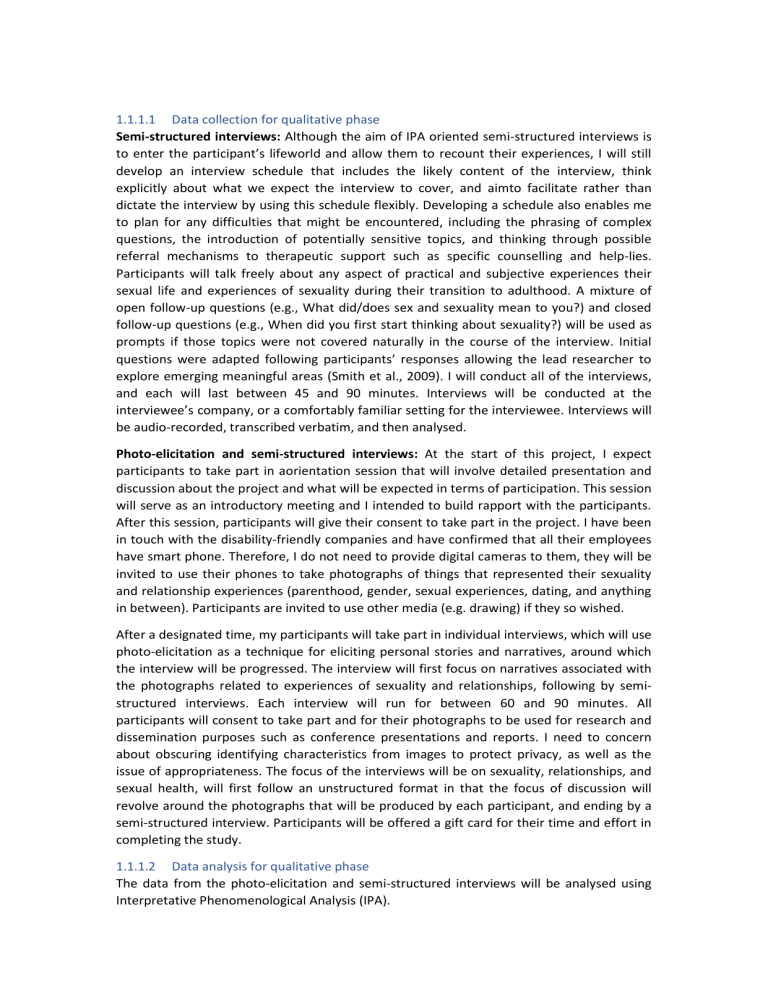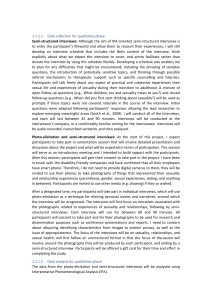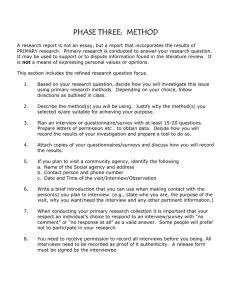Sexuality & Disability Research Proposal: Qualitative & Quantitative Methods
advertisement

1.1.1.1 Data collection for qualitative phase Semi-structured interviews: Although the aim of IPA oriented semi-structured interviews is to enter the participant’s lifeworld and allow them to recount their experiences, I will still develop an interview schedule that includes the likely content of the interview, think explicitly about what we expect the interview to cover, and aimto facilitate rather than dictate the interview by using this schedule flexibly. Developing a schedule also enables me to plan for any difficulties that might be encountered, including the phrasing of complex questions, the introduction of potentially sensitive topics, and thinking through possible referral mechanisms to therapeutic support such as specific counselling and help-lies. Participants will talk freely about any aspect of practical and subjective experiences their sexual life and experiences of sexuality during their transition to adulthood. A mixture of open follow-up questions (e.g., What did/does sex and sexuality mean to you?) and closed follow-up questions (e.g., When did you first start thinking about sexuality?) will be used as prompts if those topics were not covered naturally in the course of the interview. Initial questions were adapted following participants’ responses allowing the lead researcher to explore emerging meaningful areas (Smith et al., 2009). I will conduct all of the interviews, and each will last between 45 and 90 minutes. Interviews will be conducted at the interviewee’s company, or a comfortably familiar setting for the interviewee. Interviews will be audio-recorded, transcribed verbatim, and then analysed. Photo-elicitation and semi-structured interviews: At the start of this project, I expect participants to take part in aorientation session that will involve detailed presentation and discussion about the project and what will be expected in terms of participation. This session will serve as an introductory meeting and I intended to build rapport with the participants. After this session, participants will give their consent to take part in the project. I have been in touch with the disability-friendly companies and have confirmed that all their employees have smart phone. Therefore, I do not need to provide digital cameras to them, they will be invited to use their phones to take photographs of things that represented their sexuality and relationship experiences (parenthood, gender, sexual experiences, dating, and anything in between). Participants are invited to use other media (e.g. drawing) if they so wished. After a designated time, my participants will take part in individual interviews, which will use photo-elicitation as a technique for eliciting personal stories and narratives, around which the interview will be progressed. The interview will first focus on narratives associated with the photographs related to experiences of sexuality and relationships, following by semistructured interviews. Each interview will run for between 60 and 90 minutes. All participants will consent to take part and for their photographs to be used for research and dissemination purposes such as conference presentations and reports. I need to concern about obscuring identifying characteristics from images to protect privacy, as well as the issue of appropriateness. The focus of the interviews will be on sexuality, relationships, and sexual health, will first follow an unstructured format in that the focus of discussion will revolve around the photographs that will be produced by each participant, and ending by a semi-structured interview. Participants will be offered a gift card for their time and effort in completing the study. 1.1.1.2 Data analysis for qualitative phase The data from the photo-elicitation and semi-structured interviews will be analysed using Interpretative Phenomenological Analysis (IPA). The qualitative phase sought to understand the practical and subjective experiences of young people with physical disabilities, with regard to their sexual life and experiences of sexuality during their transition to adulthood. Therefore, it will be rooted in the interpretative tradition that aims to explore individuals’ interpretation of reality. Within the interpretative approaches, IPA is chosen as the most appropriate approach to guide my analysis, due to its emphasis on understanding a phenomenon as it is experienced and given meaning in the lived experience of a particular person. IPA is idiographic and has roots in phenomenology in that itdoes not attempt to produce an objective statement of the phenomenon itself but is committed to the detailed examination of a phenomenon as it is experienced and given meaning in the lived experience of a particular person (Smith et al., 2009). IPA does not make generalisations about larger populations, but aims to arrive at more general claims cautiously following a thorough analysis of individual cases. Commenting on the meaning-making involved in participants’ thinking is central to IPA’s hermeneutic stance (Smith et al., 2009). IPA also acknowledges that the research process depends on and is complicated by the researcher’s own conceptions (Smith, Jarman, & Osborn, 1999). Therefore, IPA is interpretative, employing a “double hermeneutic” as the researcher attempts to make sense of the participant’s sensemaking. In keeping with IPA’s idiographic, phenomenological commitment, I will analyse each interview in the current study in- depth (Smith et al., 2009). I will listen and re-read each interview carefully. Initial analyses involveme identifying and noting descriptive, linguistic and conceptual units of meaning in each interview. The transcript will be re-read and emergent themes for each interviewee will be noted, drawing on both the transcript and the initial analyses. Connections will be established between preliminary themes for each participant and themes will be clustered appropriately. Each interview’s preliminary themes will be collected, and clustered into superordinate themes representing shared higher-order qualities which will be used to structure the findings of the current study. Smith et al (2009) suggested imagining a magnet during the analytic process, with some of the themes pulling others in and helping to make sense of them. IPA as a framework is a dynamic, reiterative process characterised by an inductive cycle. As IPA is a hermeneutic analysis, I will engage in reflective journaling throughout the study to document personal opinions, biases and motivations, and critical reflections on the research process which would be helpful in aiding reflection on how I am “making sense of the participant’s sense making”. Analysis will be conducted of text and photographs in parallel, with iterative crossreferencing of emerging themes. Content analysis of the photographs will explore similarities and differences between objects, sceneries or people taken by the participants and aimed to complement the thematic analysis. In-depth interviews will be transcribed verbatim and coded using NVivo 11 analysis software. Thematic analysis of the transcripts will identify themes and subthemes from data. I will then triangulate concepts emerging from the transcripts and photographs, analysing each photograph in relation to the meanings that the participants attached to it. Each photograph will then be allocated themes and sub-themes that will be identifies through the thematic analysis, with supporting quotes referring to the photograph. 1.1.2 Phase two: Quantitative 1.1.2.1 Online questionnaire In order to gather suitable data to answer the research questions from a wider perspective in the second phase, I will develop an online questionnaire and distribute online across the country. A questionnaire is a data collection method that is completed by targeted participants, with the intent of discovering individuals’ thoughts on a specific item (Cannon, 2015). The questionnaire method has many advantages compared to the interview method. First, it generates answers from a large group of participants at low cost; secondly, questionnaire provide respondent anonymity; and finally, there is less interviewer bias (Pilot & Beck, 2004; Cannon. 2015; Burns & Grove, 2005). I will develop the questionnaire to ensure that it is culturally and linguistically sensitive instrument. The assurance of cultural and linguistic sensitivity can be met by drawing the instrument from the actual quotes and experiences of young people from the first phase, to emphasis the fact that it is true to their context and does not impose a different world view or language. The online questionnaire will be formulated based on the findings from the first stage of the study. The aim of the second stage is to try and explore whether the themes found through the photographs and semi-structured interviews could be extended or are applicable to a relatively larger and varied population. In this present study, I will design a closed-ended format questionnaire, as I am motivated by the fact that this would be balanced with a qualitative section, which would enable participants to have the freedom to express their views on issues. In moving from qualitative analysis to developing a questionnaire, the codes become variables, themes become scales, and the quotations become survey items. The quantitative data collection can incorporate both open-ended answers as well as scale-based questions. The language from the qualitative data can be used in forming questions. 1.1.2.2 Participants in quantitative phase The online survey will be post on Sina Weibo and WeChat Moments to reach young people with physical disabilities, circulate via employers, and snowball sampling by asking young people to refer others, along with an invitation to participate, explaining that the online survey aims to find out about the understandings and lived experiences of the sexuality of young people with physical disabilities in China while transitioning to adulthood. It will be made very clear that the survey is based on semi-structured interviews, and that the survey aims to find out whether their experiences are similar to, or different from, a wider group. In order to generalize from a random sample and avoid sampling errors or biases, a random sample needs to be of adequate size. According to the results of China’s most recent national survey of persons with disabilities (China Disabled Persons’ Federation, 2006), there are about 8 million young people between the ages of 10 and 19 with visual, hearing, intellectual or multiple disabilities. (I cannot find the statistics for young people between 18 to 24 with physical disabilities only, but by different disabilities, physically disabled accounted for 29.07%), I estimate 2 million between 18 to 24 have physical disabilities.With this estimate, I projected an optimal sample size for this quantitative phase using an online sample size calculator found here: http://www.surveysystem.com/sscalc.htm. Sample size calculator results show that in order for my survey findings to be generalizable to the broader population of young people with physical disabilities, with a confidence level of 95% and a confidence level of ±5, I will need 384 questionnaire respondents. 1.1.2.3 Validity and reliability of the survey instrument I will conduct a pilot study involving participants from my qualitative phase in order to check how long theprocess of collecting data would take, to collect respondents’ feedback in order to be used to revise the survey’s content, and to verify the validity and reliability of the survey instruments. During the pilot study they will be asked to review the survey and comment on whether and to what extent questions and possible responses are reflective of the themes from the semi-structured interviews. The respondents’ feedback will help to improve the quality of the survey in terms content coverage and content validity of the scales as well as detecting some language and technical mistakes. 1.1.2.4 Data analysis for quantitative phase In keeping with an exploratory sequential mixed methods research design, data analysis will be done in two phases linked sequentially to the qualitative and quantitative phases of data collection. Survey responses will be analyzed using descriptive statistics and inferential statistics. Descriptive statistics will be used to review and present the data collected from the respondents (Aron et al., 2005). For example, descriptive statistics will be employed to describe the participants’ demographic characteristics, using the mode and frequency distribution. In contrast, inferential statistics will be utilized to draw conclusions about to what extent there is a link between attitudes to intimate relations and gender. The results from the surveys were then viewed in light of the themes that emerged from the interviews and their relationship will be examined. 2. Ethical approach I will obtain ethical approval for all data outlined above from LSHTM and Peking University. I worked in Peking University for a year prior to joining LSHTM, and I remain in contact with researchers from the School of Public Health of Peking University. They will assist me in ethics application in China. I will give explanations about the study to participants, and obtain consent from each of them. I will assure participants that they would not be identifiable to readers of the thesis or associated publications or presentations, and their data will remain confidential. I will use pseudonyms to protect the identities of the participants, and the names of places as well as their companies’ names that will be likely to reveal the identity of participants will be withheld. I will ensure that the psychological and physical wellbeing of both myself and the participants are safeguarded. I will take the time to build rapport and trust with each participant to ensure that they feel safe during the interview, by being warm, empathic, engage in active listening and pacing the interview according to the participants’ needs. After the interviews, I will provide participants with a list of appropriate sources of support. It is also important to consider the ethical implications of interpreting data as a non-disabled researcher, conducting research with participants with physical disabilities. While I might empathise with my participants’ experiences and achieve a understanding, I have no personal experience of disabilities. When I decide to undertake this research I am concerned about how this lack of experience will impact on my research. However, the IPA approach assumes that while the researcher might be the theoretical expert, the participant is the expert of their own experience (Smith et al., 2009). Therefore, it is not necessary for the researcher to have a particular experience in order to explore that experience.



